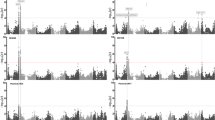Abstract
Early vigor, earliness and cold tolerance are the main potential contributions of European maize (Zea mays L.) for breeding programs for adaptation to areas with short growing seasons and cold springs. The objective of this research was to determine the potential contributions of populations from different European regions to breeding for adaptation. Six Spanish and six French maize populations differing on variability for earliness, vigor and cold tolerance were crossed in a complete diallel without reciprocals. The populations and their crosses were evaluated in the field and in a cold chamber. Minimum temperatures were the main environmental trait affecting genotype × environment interaction, probably due to the cold sensitivity of the genotypes with the best performance in the field. The best population cross, based on specific heterosis for adaptation-related traits in the field, was Viana × Rastrojero, but this cross was cold sensitive. Tuy × Lazcano should be the best choice for a breeding program for adaptation, based on performance in the field and cold tolerance. As conclusions, there was variability for earliness, vigor and cold tolerance among the populations and crosses involved in this study, being tolerant to cold conditions the populations with medium growing cycle originated in areas with short growing seasons. The highest yielding crosses were cold sensitive.
Similar content being viewed by others
References
Cochran WG, Cox GM (1957) Experimental designs, 2nd edn. John Wiley and Sons, New York
Gardner CO, Eberhart SA (1966) Analysis and interpretation of the variety cross diallel and related populations. Biometrics 22:439–452
Keeratinijakal V, Lamkey KR (1993) Responses to reciprocal recurrent selection in BSSS and BSCB1 maize populations. Crop Sci 33:73–77
Malvar RA, Revilla P, Butrón A, Gouesnard B, Boyat A, Soengas P, Álvarez A, OrdÁs A (2005) Performance of crosses among French and Spanish maize populations across environments. Crop Sci. 45:1052–1057
Moreno-González J (1988) Diallel crossing system in sets of flint and dent inbred lines of maize (Zea mays L.). Maydica 33:37–49
Moreno-González J, Ramos-Gourcy F, Losada E (1997) Breeding potential of European flint and earliness-selected U.S. Corn Belt dent maize populations. Crop Sci 37:1475–1481
Ordás A (1991) Heterosis in crosses between American and Spanish populations of maize. Crop Sci 31:931–935
Ordás A, Revilla P, Malvar RA, Cartea ME (1994) Development of sweet corn hybrids adapted to the environmental conditions of the northwest of Spain. Maydica 39:171–175
Rebourg C, Chastanet M, Gouesnard B, Welcker C, Dubreuil P, Charcosset A (2003) Maize introduction in Europe: the history reviewed in the light of molecular data, Theor Appl Genet 106:895–903
Revilla P, Boyat A, Álvarez A, Gouesnard B, Soengas P, OrdÁs A, Malvar RA (2006) Heterotic patterns among French and Spanish maize populations. Maydica (in press)
Revilla P, Butrón A, Malvar RA, Ordás A (1998) Identifying open-pollinated populations of field corn as sources of cold tolerance for improving sweet corn. Euphytica 101:239–247
Revilla P, Butrón A, Malvar RA, Ordás A (1999) Relationships among kernel weight, early vigor, and growth in maize. Crop Sci 39:654–658
Revilla P, Malvar RA, Cartea ME, Soengas P, Ordás A (2002) Heterotic relationships among European maize inbred lines. Euphytica 126:259–264
Revilla P, Soengas P, Cartea ME, Malvar RA, Ordás A (2003) Isozyme variability among European maize populations and the introduction of maize in Europe. Maydica 48:141–152
SAS (2000) The SAS System. SAS OnlineDoc.HTML Format. Version eight. SAS Institute, Cary, North Carolina
Acknowledgements
Research supported by the Ministry of Science and Technology (Ref. HF1999-0138), the Ministère de l’Education Nationale et de la Recherche, the Committee for Science and Technology of Spain (Project AGL2004-06776), the Autonomous government of Galicia (PGIDIT04RAG403006PR), the Excma. Diputación Provincial de Pontevedra, and the European Union (RESGEN 88 CT96).
Author information
Authors and Affiliations
Corresponding author
Rights and permissions
About this article
Cite this article
Revilla, P., Boyat, A., Álvarez, A. et al. Contribution of autochthonous maize populations for adaptation to European conditions. Euphytica 152, 275–282 (2006). https://doi.org/10.1007/s10681-006-9214-4
Received:
Accepted:
Published:
Issue Date:
DOI: https://doi.org/10.1007/s10681-006-9214-4




